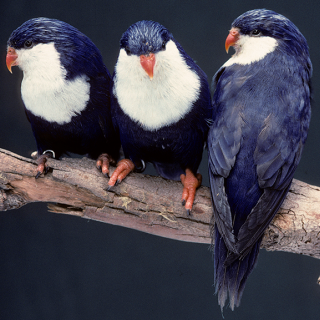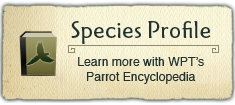Project Regions:
Blue Lorikeet |
|
|
Collaborators/Funders
University of Leeds, The Cook Islands Natural Heritage Trust
Tiny lorikeet in danger on isolated Pacific islands
Listed as Vulnerable in the wild, the Blue Lorikeet (Vini peruviana) is threatened by introduced predators and increasing numbers of severe storms.
Project progress: The World Parrot Trust funded a census in 2010 on the island of Aitutaki to determine the extent of Cyclone Pat's impact on the Blue Lorikeet's population.
Outcomes: Research found that the storm caused the loss of half the island's population, leaving only 1448 birds. Researchers and students continue to monitor numbers. Suggested conservation actions include conducting surveys to determine population numbers and status on known islands, and to continue monitoring the population on Aitutaki. Studying the species' ecological requirements, and establishing education programmes on select islands was also recommended.
Wild population: 1500-7000, decreasing.
Where found: Occurs on Society Islands and W Tuamotu Archipelago; formerly further afield. Introduced to Aitutaki, S Cook Islands.
History: The Blue Lorikeet (Vini peruviana) is at risk from introduced predators, and numerous other human-mediated events. Recent hurricane activity has also reduced numbers - in February 2010, Cyclone Pat hit Aitutaki directly and caused the loss of 50% of the population, leaving an estimated 1448 birds. (Jennings, 2010). This event changed the demographics of the population as virtually all of the juvenile birds were lost. The predicted increase in violent storms possibly due to climate change, cumulative effects of repeated breeding failures and loss of individuals could dramatically increase the likelihood of extinction (Jennings, 2011).
Threats:
- Potential increase in storm activity due to climate change
- Introduction and predation by Black Rats (Rattus rattus) and feral cats (Felis cattus)
- Reduction in range on the Society Islands
- Spread of introduced Swamp Harrier (Circus approximans)
Ecology: The Blue Lorikeet occurs on the Society Islands and W Tuamotu Archipelago in the South Pacific Ocean, as well as Aitutaki in the South Cook Islands as an introduced species. These tiny birds are seen in coconut plantations or gardens with flowering banana and mango trees. On Aituaki, this species prefers mixed woodland with banana trees and coconut palms, plantations with shade trees and tall forest. Preferred foods are nectar and insects. This lorikeet has been recorded foraging for insects on the undersides of leaves, a behaviour quite unlike other lories and lorikeets.
Project Updates
WPT-sponsored research:
The impact of Cyclone Pat on the Blue Lorikeet population of Aitutaki, Cook Islands
Other publications:
Google scholar - Vini peruviana


































